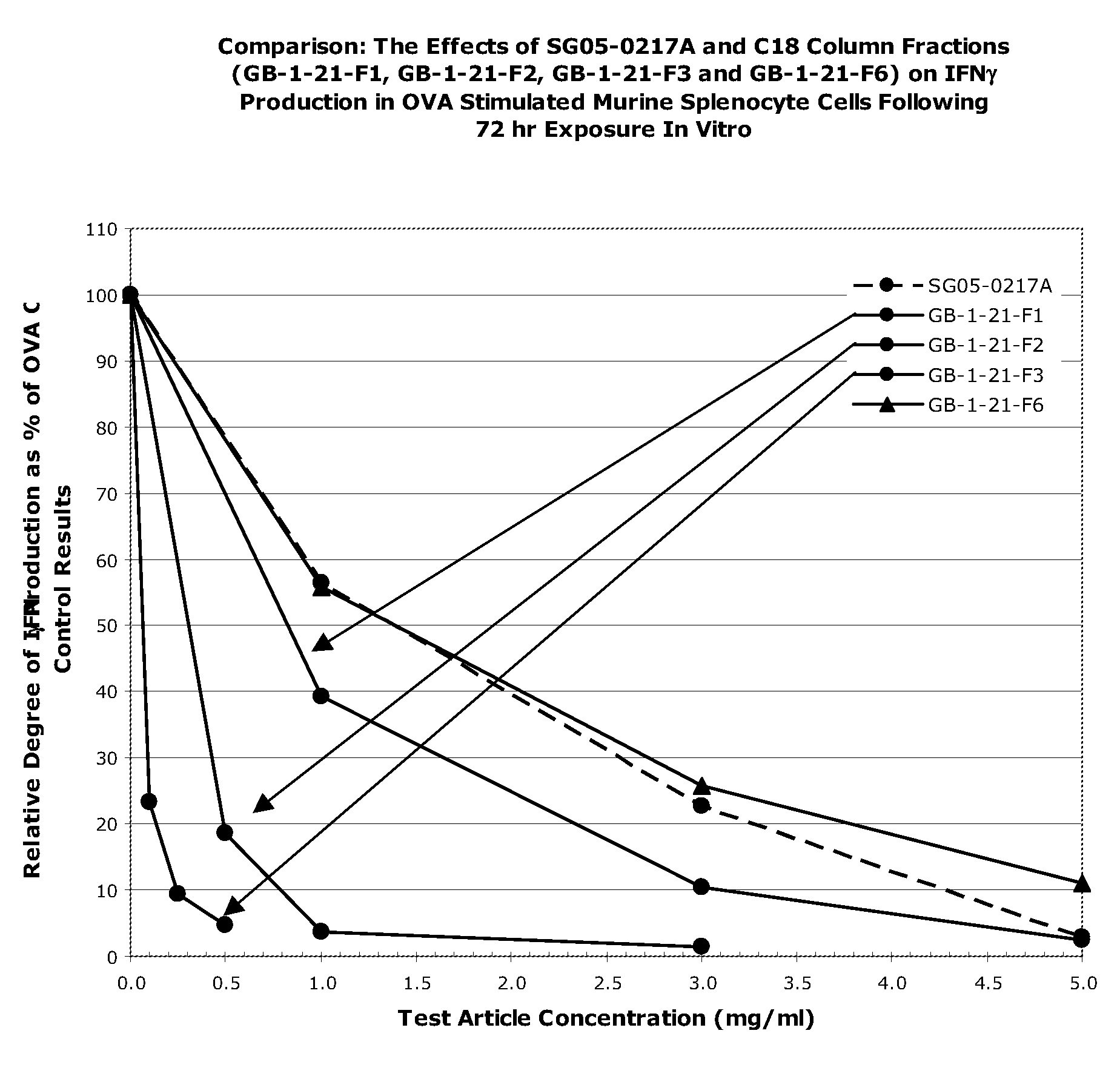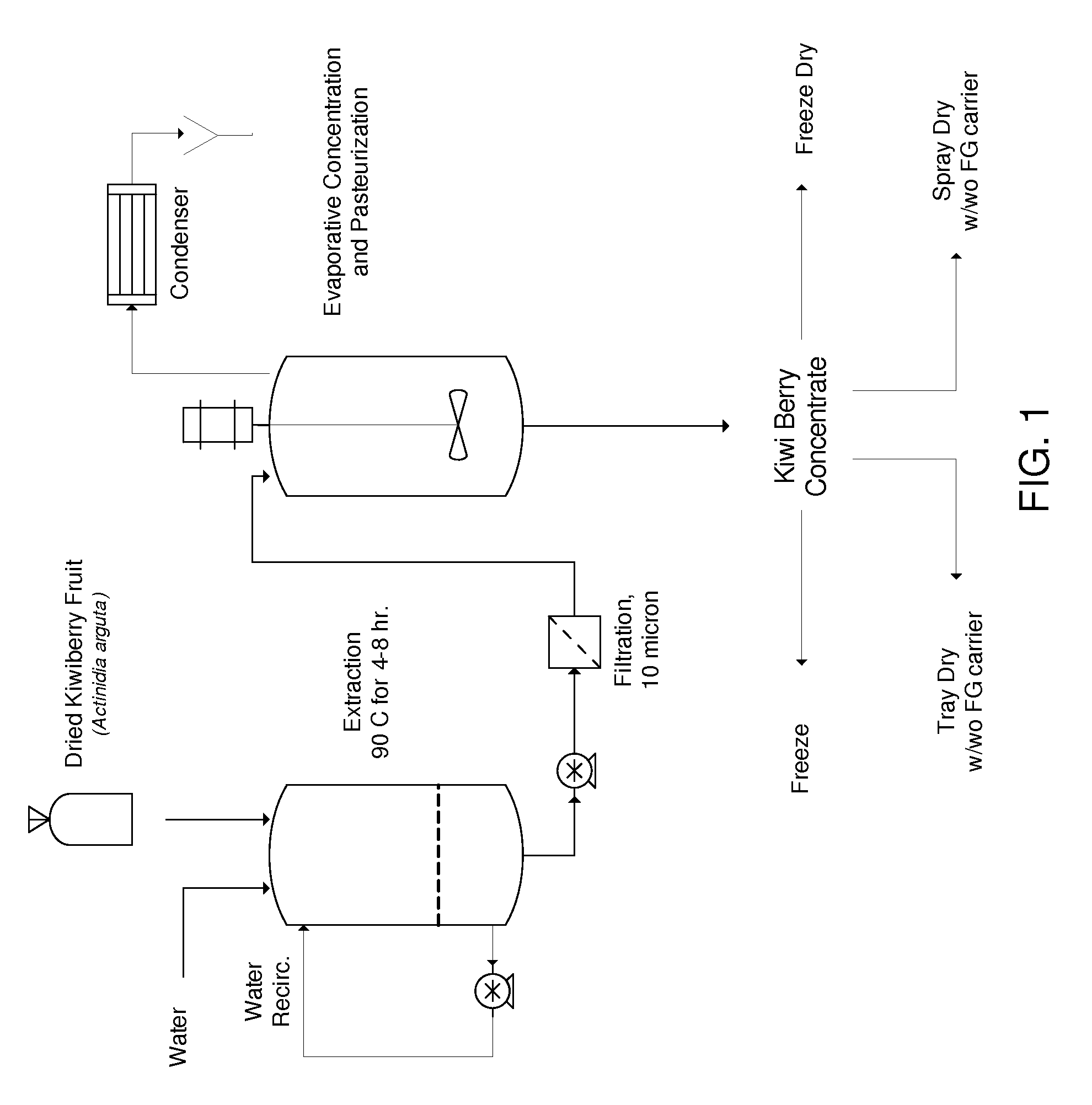Combination Therapy Comprising Actinidia and Steroids and Uses Thereof
a technology of actinidia and steroid, which is applied in the direction of drug compositions, biocide, immunological disorders, etc., can solve the problems of tissue damage and sometimes death, erosion and destruction of cartilage, collagen and bone, and cardiovascular system, and achieve the effect of reducing at least one symptom of inflammation
- Summary
- Abstract
- Description
- Claims
- Application Information
AI Technical Summary
Problems solved by technology
Method used
Image
Examples
example 1
[0138]The following example shows the preparation of various preparations comprising A. arguta that were used in the examples below.
Plant Material
[0139]Stems (consisting of canes and fruiting spurs), roots, and bark of Actinidia arguta (Sieb. Et Zucc.) Planch. ex Miq. (Actinidaceae) cultivar ‘Ananasnaya’ were collected at Hurst Berry Farm, Sheridan, Oreg. A voucher specimen (#518640) was authenticated by Mr. Tim Hogan, Collection Manager, University of Colorado Herbarium, The University of Colorado, Boulder, Colo., and deposited at the same location. Plant material was air dried 48 hours and stored at room temperature prior to extraction or other processing.
[0140]Ripe, ready-to-eat A. arguta fruit were collected at Hurst Berry Farm, frozen immediately, shipped and stored frozen (−20° C.) prior to extraction or other processing.
Extracts and Other Preparations
[0141]Powdered stems (126.6 g), powdered roots (79.0 g), and finely divided bark (126.2 g) were each extracted with distilled w...
example 2
[0149]The following example describes in vitro testing for immunomodulating activity in A. arguta preparations.
[0150]The purpose of this study was to compare the relative ability of various extracts and preparations produced from A. arguta to modulate cytokine production (IL-4, IL-5, IL-10, IL-13, and IFNγ) in splenocyte cultures derived from ovalbumin (OVA, grade V, Sigma)-sensitized mice using ELISA (Quantikine kits, R&D systems) analysis. The following samples (prepared as described in Example 1 above) were tested: FD001 (PG102T), the fruit juice concentrate, and the EtOAc extract.
Splenocyte Isolation and Culturing
[0151]Female, Balb / c mice (Harlan, Indianapolis, Ind.) were sensitized by IP injection of 20 μg OVA on days 0 and 14. On day 24, following euthanasia by cervical dislocation, spleens were aseptically removed from individual mice and immediately processed for splenocyte culture development using sterile technique. The spleens were dissociated in the presence of 10 mM HEP...
example 3
[0156]The following example describes a comparison of in vitro activity of extracts of non-fruit parts of A. arguta, as well as alternative fruit preparations of A. arguta.
[0157]The purpose of this study was to assess the ability of A. arguta extracts that originate from plant parts other than the fruit, or from alternative preparations of the fruit (i.e., other than the extracts described in U.S. Patent Publication No. 2004 / 0037909, supra), to modulate cytokine production (IL-13 and IFNγ) in splenocyte cultures derived from ovalbumin-sensitized mice, using ELISA analysis. The following samples (prepared as described above) were tested: water extracts of the stem, root, and bark of A. arguta, prepared as described in Example 1; “boiled” fresh fruit preparations; the fruit juice concentrate prepared as described in Example 1; FD001 (large scale equivalent of PG102T) prepared as described in Example 1; FD001 powder prepared as described in Example 1 (used for clinical trials describe...
PUM
 Login to View More
Login to View More Abstract
Description
Claims
Application Information
 Login to View More
Login to View More - R&D
- Intellectual Property
- Life Sciences
- Materials
- Tech Scout
- Unparalleled Data Quality
- Higher Quality Content
- 60% Fewer Hallucinations
Browse by: Latest US Patents, China's latest patents, Technical Efficacy Thesaurus, Application Domain, Technology Topic, Popular Technical Reports.
© 2025 PatSnap. All rights reserved.Legal|Privacy policy|Modern Slavery Act Transparency Statement|Sitemap|About US| Contact US: help@patsnap.com



